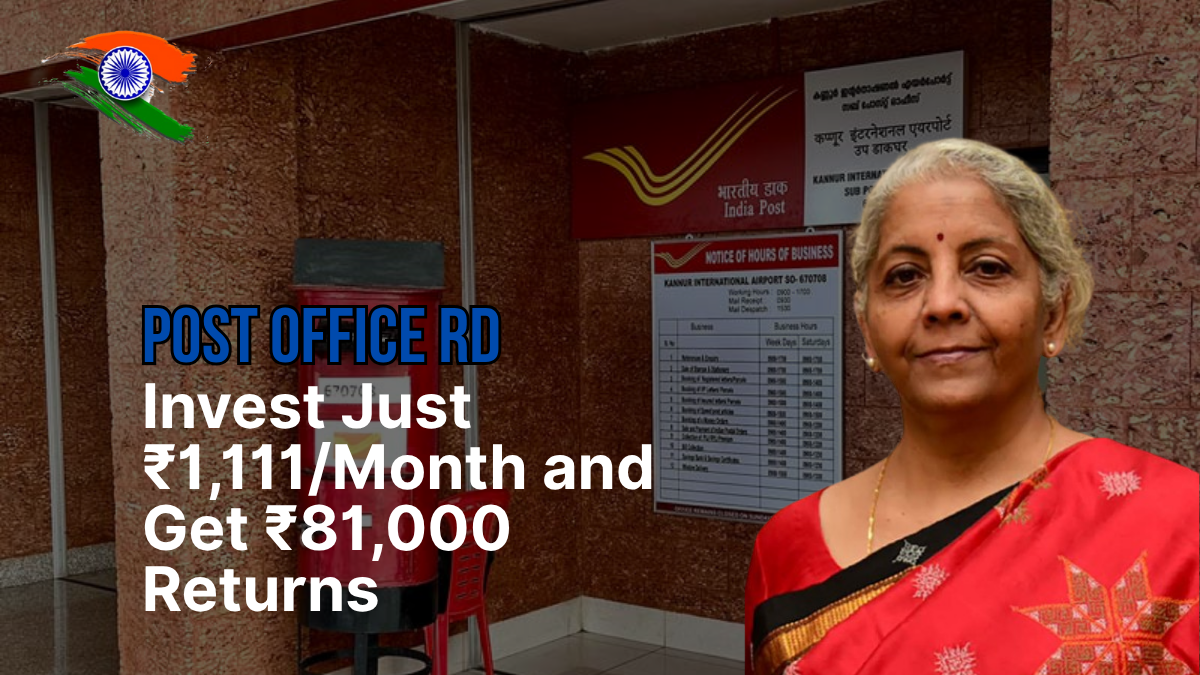In today’s uncertain economic environment, investors seek financial instruments that offer both security and consistent returns. One such reliable savings tool is the Post Office Recurring Deposit (RD) scheme. This government-backed initiative not only assures the safety of capital but also delivers steady returns, making it ideal for conservative investors, first-time savers, and those planning for medium-term financial goals.

This detailed guide explains how investing just ₹1,111 per month in a Post Office RD can grow into approximately ₹81,000 in five years. From the structure of the scheme to tax implications and strategic planning, we cover everything you need to know.
Short Summary: Post Office Recurring Deposit (RD)
| Key Detail | Information |
|---|---|
| Scheme Name | Post Office Recurring Deposit (RD) |
| Monthly Investment | ₹1,111 |
| Investment Tenure | 5 Years (60 Months) |
| Interest Rate | 6.7% per annum (compounded quarterly) |
| Maturity Amount | Approximately ₹81,000 |
| Minimum Deposit | ₹100 per month |
| Government Backed | Yes |
| Official Website | https://www.indiapost.gov.in |
Understanding the Post Office RD Scheme
Key Features
| Feature | Details |
| Interest Rate | 6.7% per annum (Q1 FY25) |
| Tenure | 5 years (60 months) |
| Compounding Frequency | Quarterly |
| Minimum Investment | ₹100/month |
| Maximum Investment | No limit |
| Investment Increment | Multiples of ₹10 |
| Backed by | Government of India |
The quarterly compounding helps investors earn more compared to simple interest-based schemes.
Compound Interest Formula
Where:
- A = Maturity amount
- P = Monthly deposit
- r = Annual interest rate (6.7%)
- t = Tenure (in years)
Returns Calculation: How ₹1,111 Grows to ₹81,000
Year-Wise Growth Table
| Year | Total Deposits | Interest Earned | Account Balance |
| 1 | ₹13,332 | ₹447 | ₹13,779 |
| 2 | ₹26,664 | ₹1,789 | ₹28,453 |
| 3 | ₹39,996 | ₹4,035 | ₹44,031 |
| 4 | ₹53,328 | ₹7,403 | ₹60,731 |
| 5 | ₹66,660 | ₹14,340 | ₹81,000 |
The interest component increases sharply over time due to the power of compounding.
Opening a Post Office RD Account
Documentation Required
| Document Type | Accepted Proofs |
| Identity Proof | Aadhaar, PAN, Voter ID |
| Address Proof | Aadhaar, utility bills, rent agreement |
| Age Proof | Birth certificate, Aadhaar |
| Photographs | 2 passport-size color photos |
| Initial Deposit | Minimum ₹100 |
Step-by-Step Process
- Visit your nearest post office.
- Collect and fill out the RD account form.
- Attach documents and passport photos.
- Submit the form with your first deposit.
- Post office staff verifies the documents.
- Receive passbook and account number.
Digital Access
- Some branches support online account opening via the India Post Payments Bank (IPPB) app.
- Payments can be made through UPI and Net Banking.
Loan Against Post Office RD
After 12 months of continuous deposits, you can take a loan:
| Loan Feature | Details |
| Eligibility | After 1 year |
| Max Loan Amount | Up to 50% of RD balance |
| Interest Rate | RD rate + 2% |
| Processing Time | 2-3 working days |
Example: After 2 years, if your balance is ₹28,453, you can get a loan of up to ₹14,226.
Tax Implications
| Tax Element | Details |
| Principal | Not tax-deductible |
| Interest Earned | Fully taxable under your income slab |
| TDS | Not deducted by post office |
| Tax Planning | Requires self-assessment and advance tax |
Effective Post-Tax Return:
- 5% slab: ~6.37%
- 20% slab: ~5.36%
- 30% slab: ~4.69%
RD vs. Other Investments
| Investment Option | Return Rate | Risk | Liquidity | Tax Benefit | Govt Backed |
| Post Office RD | 6.7% | Very Low | Moderate | No | Yes |
| PPF | 7.1% | Very Low | Low | Yes | Yes |
| NSC | 6.8% | Very Low | Very Low | Yes | Yes |
| Bank RD | 5.5-6.5% | Low | Moderate | No | Partially |
| ELSS Funds | 12-15% | High | Moderate | Yes | No |
Smart Investing Strategies
- Laddering: Open multiple RD accounts at different intervals to ensure regular liquidity.
- Step-up Investment: Gradually increase your monthly contribution as your income grows.
- Family Coordination: Open accounts for spouse/children to manage taxes and expand investments.
Common Mistakes and How to Avoid Them
| Mistake | Solution |
| Missed Payments | Set up auto-debit or reminders |
| No Nomination | Assign nominee during account opening |
| Ignoring Tax Impact | Include RD income in annual returns |
| Premature Withdrawals | Keep emergency fund separately |
FAQs: Post Office RD
Q1: Can I open a Post Office RD online?
Ans. Yes, through the IPPB app in select areas.
Q2: Is interest earned on RD tax-free?
Ans. No, it is fully taxable based on your slab.
Q3: Can I withdraw before maturity?
Ans. Yes, after 3 years with penalties.
Q4: Is the RD amount safe?
Ans. Yes, it’s fully backed by the Government of India.
Q5: How is interest calculated?
Ans. Quarterly compounding at 6.7% per annum.
Conclusion
The Post Office RD scheme remains one of the safest and most disciplined ways to save for medium-term goals. A monthly investment of just ₹1,111 leads to wealth accumulation of over ₹81,000 in five years, showing the real power of compounding.
With the backing of the Indian government and the convenience of increasing digital services, Post Office RD continues to be a trusted investment avenue. For those seeking low-risk, fixed-income investments with guaranteed returns, this scheme offers peace of mind and steady growth.
Click here to know more